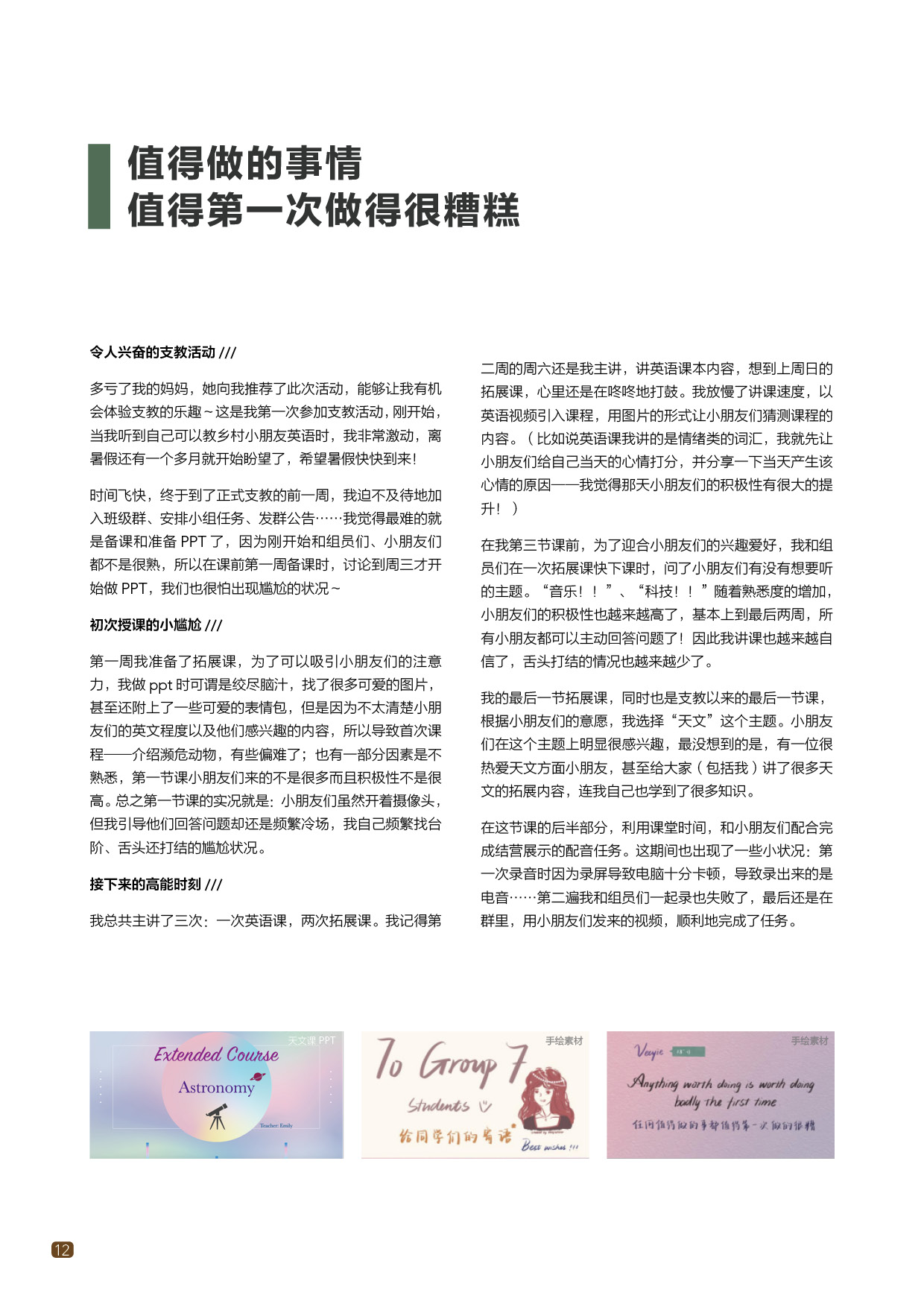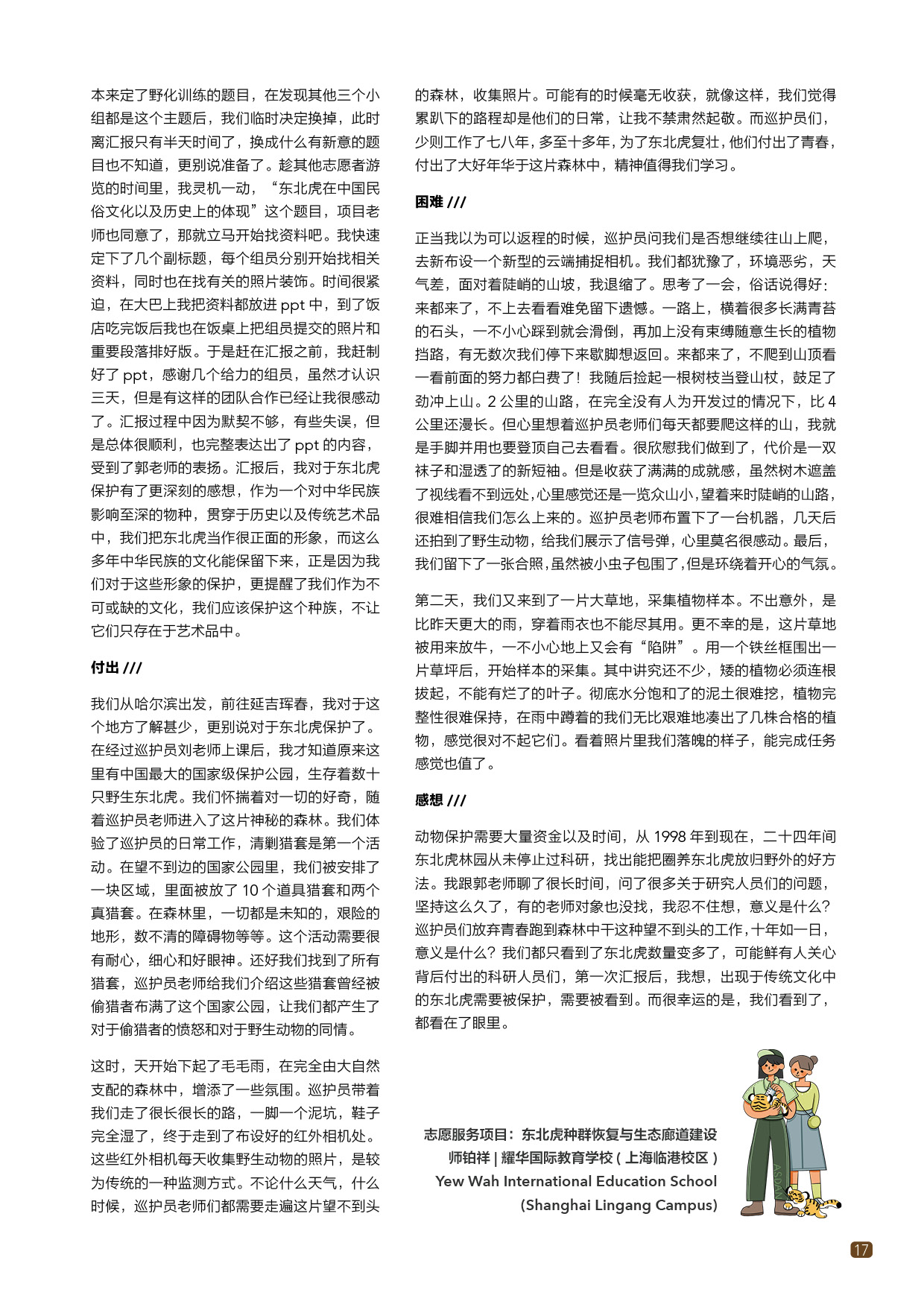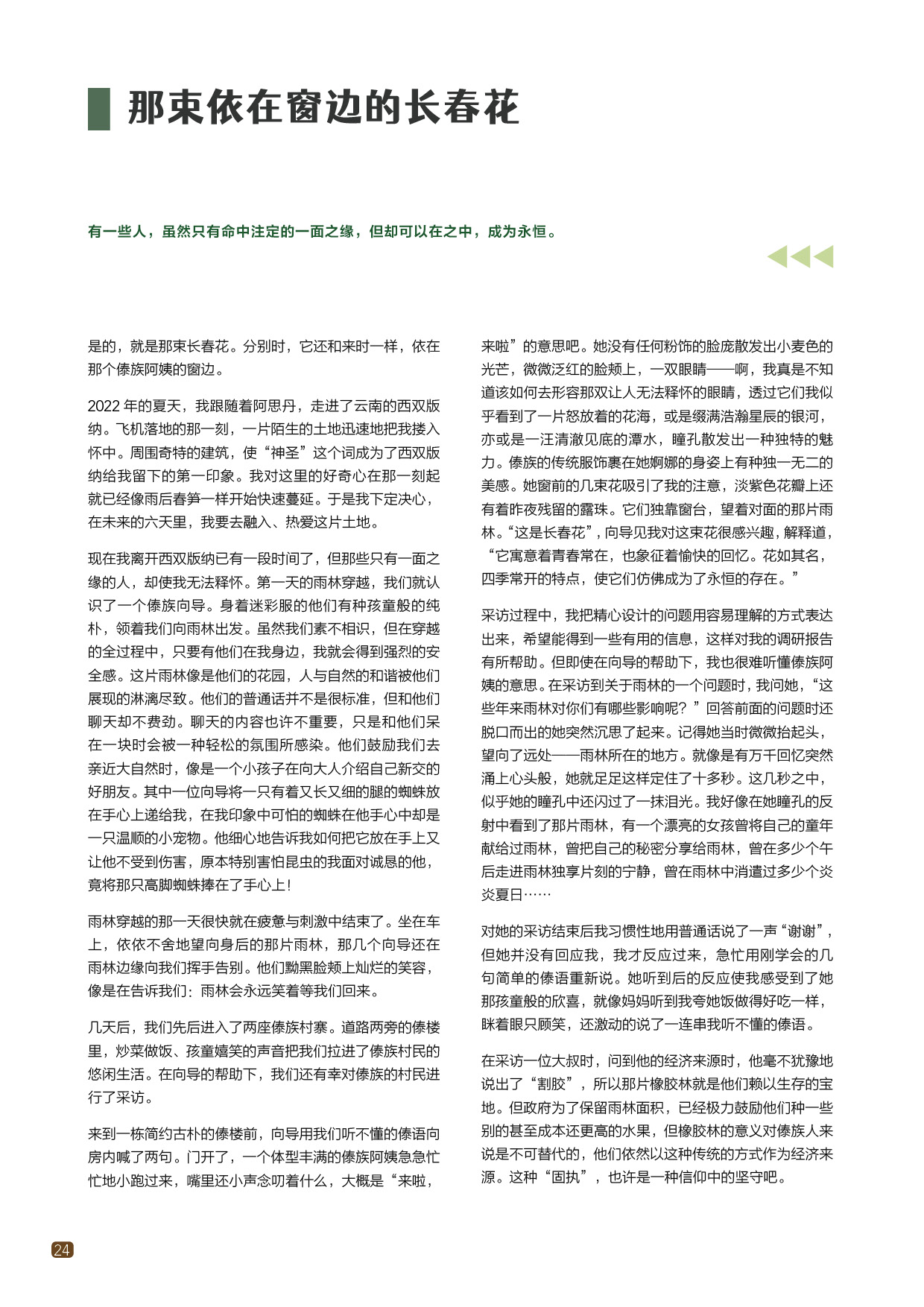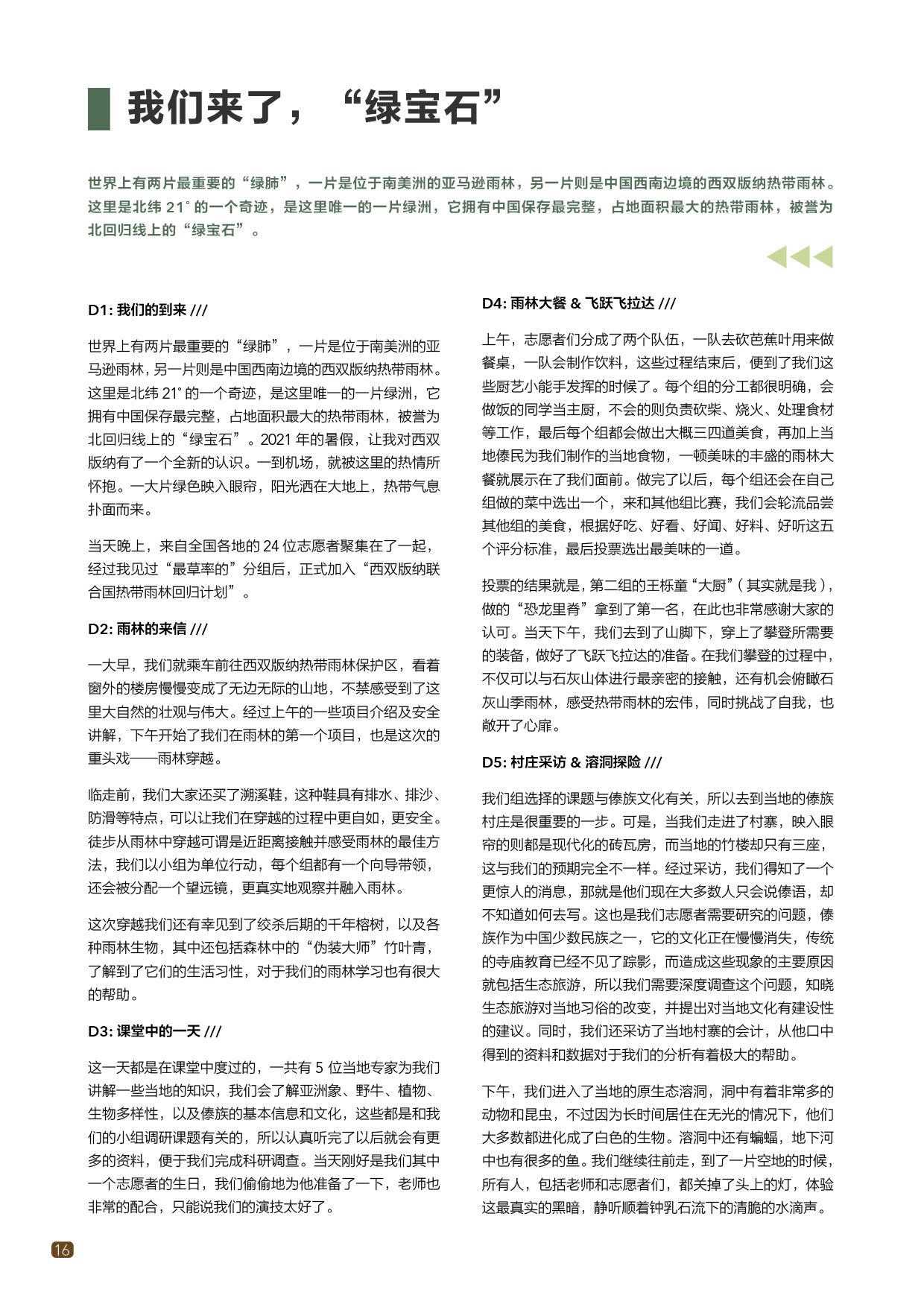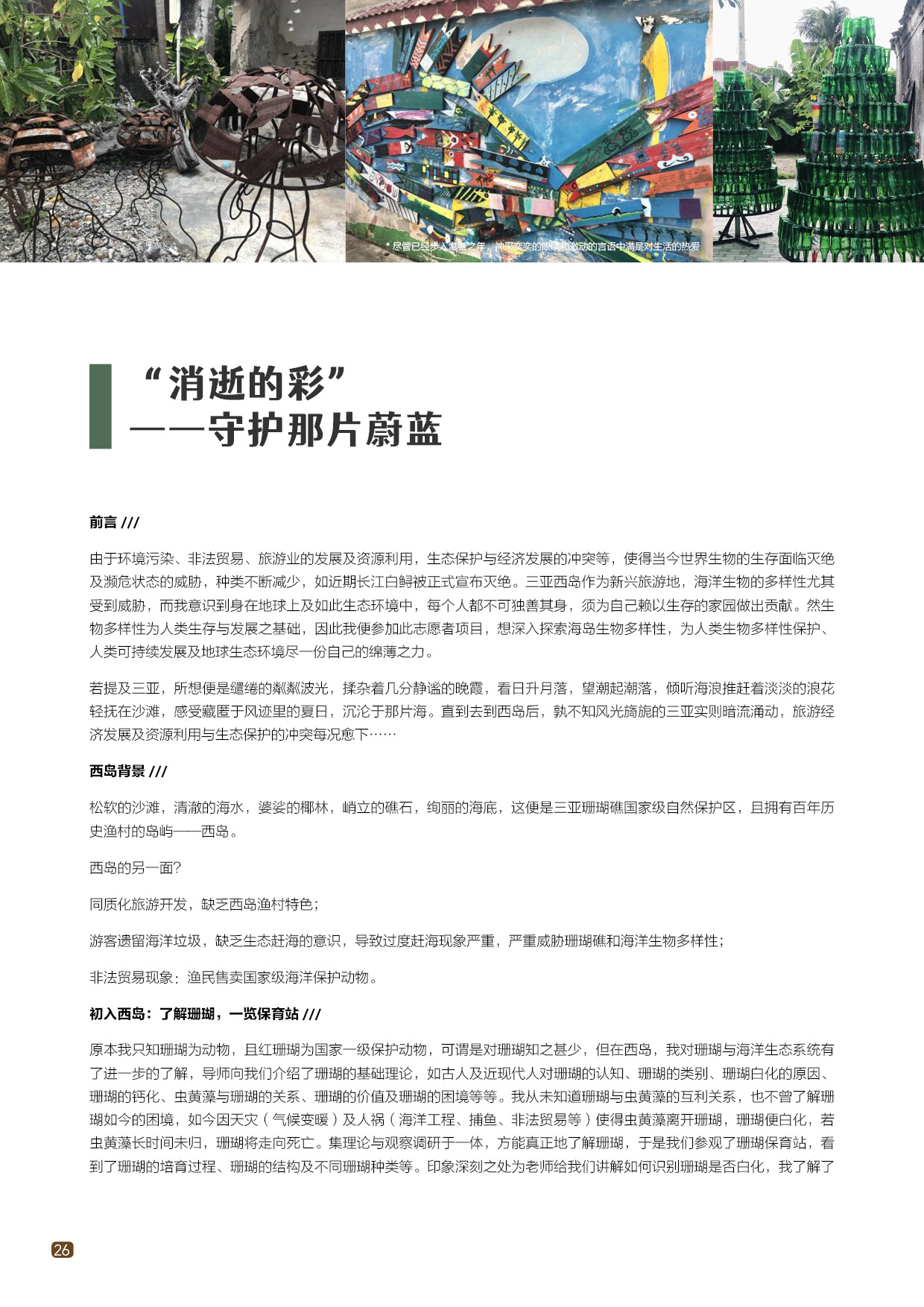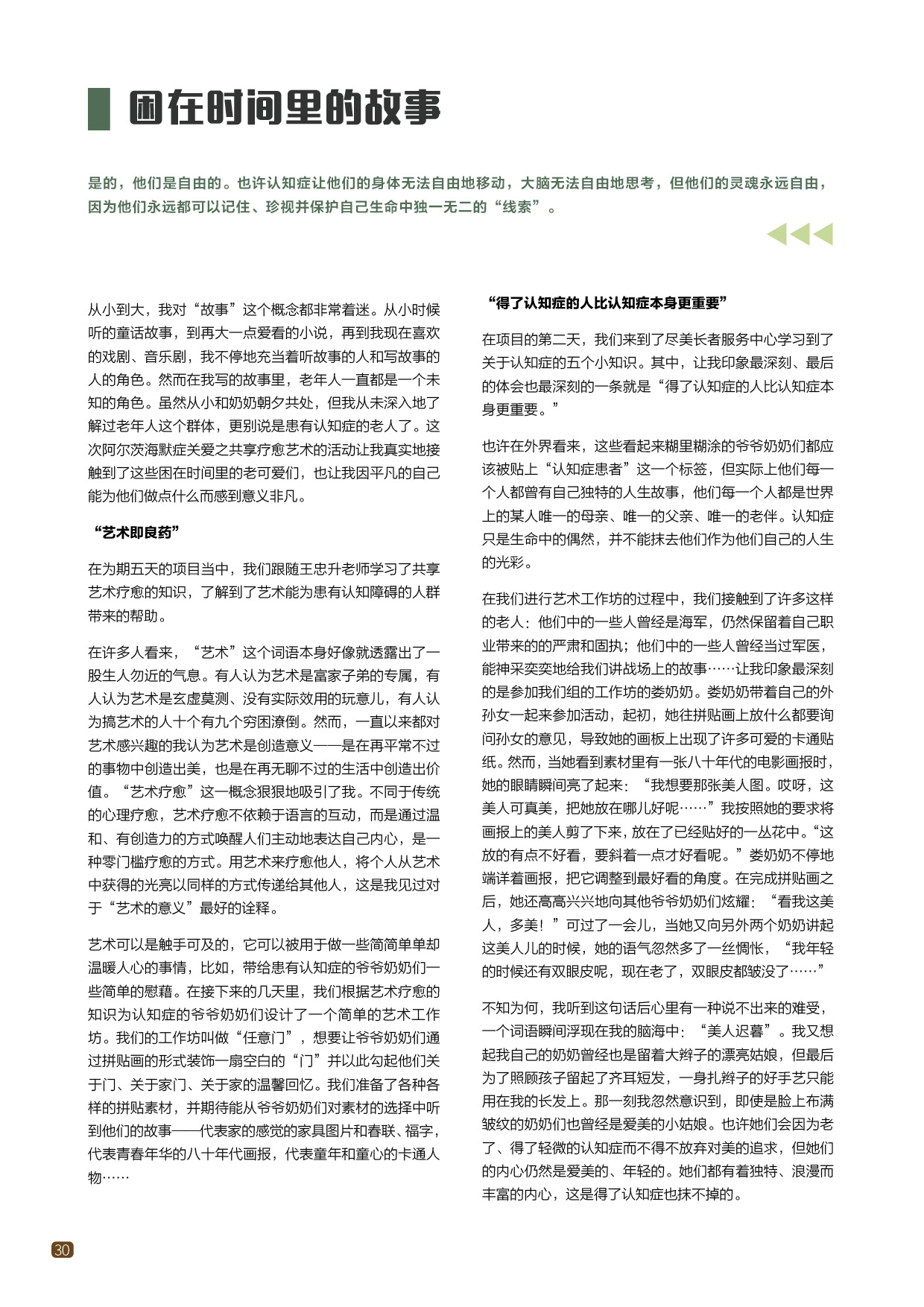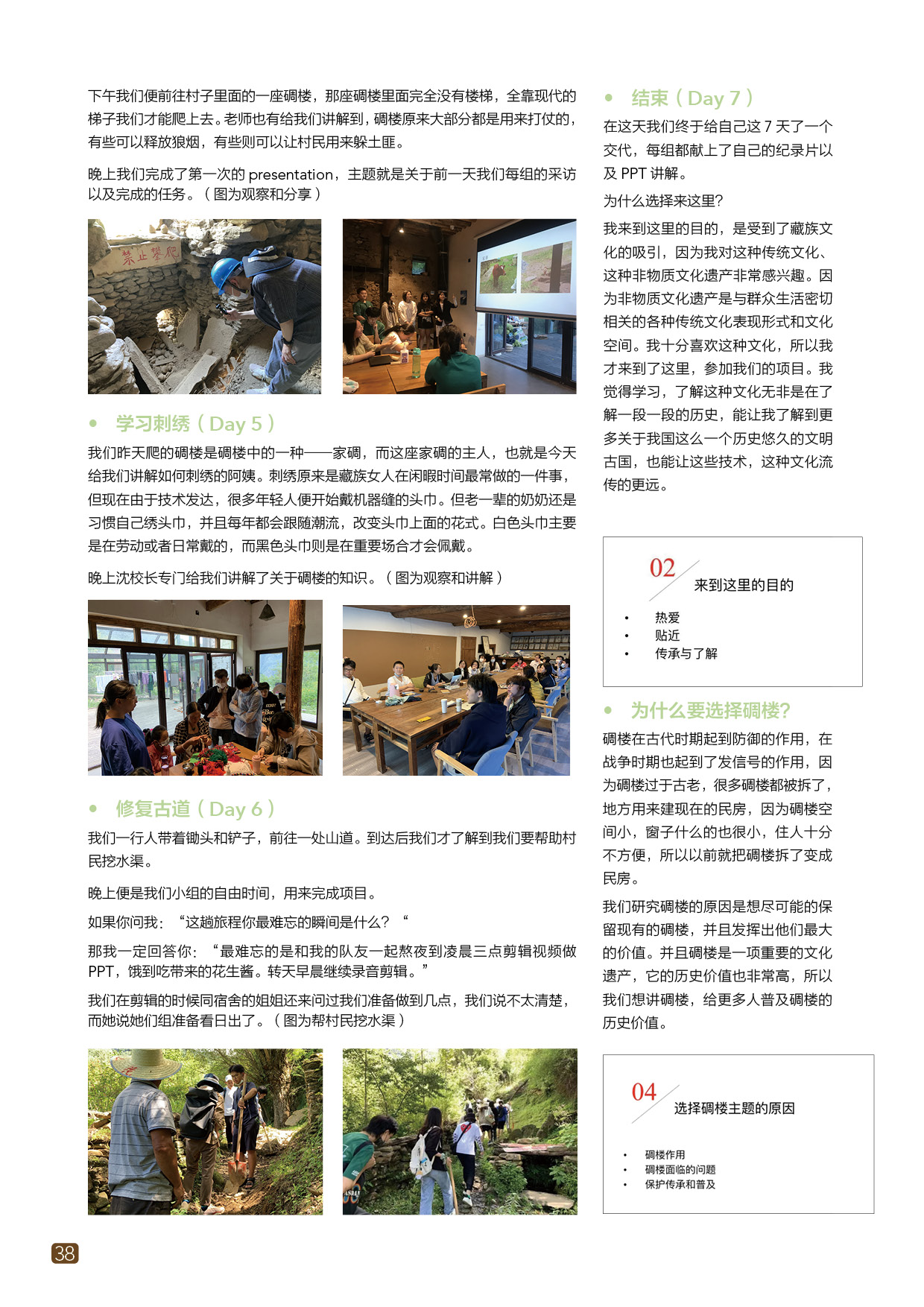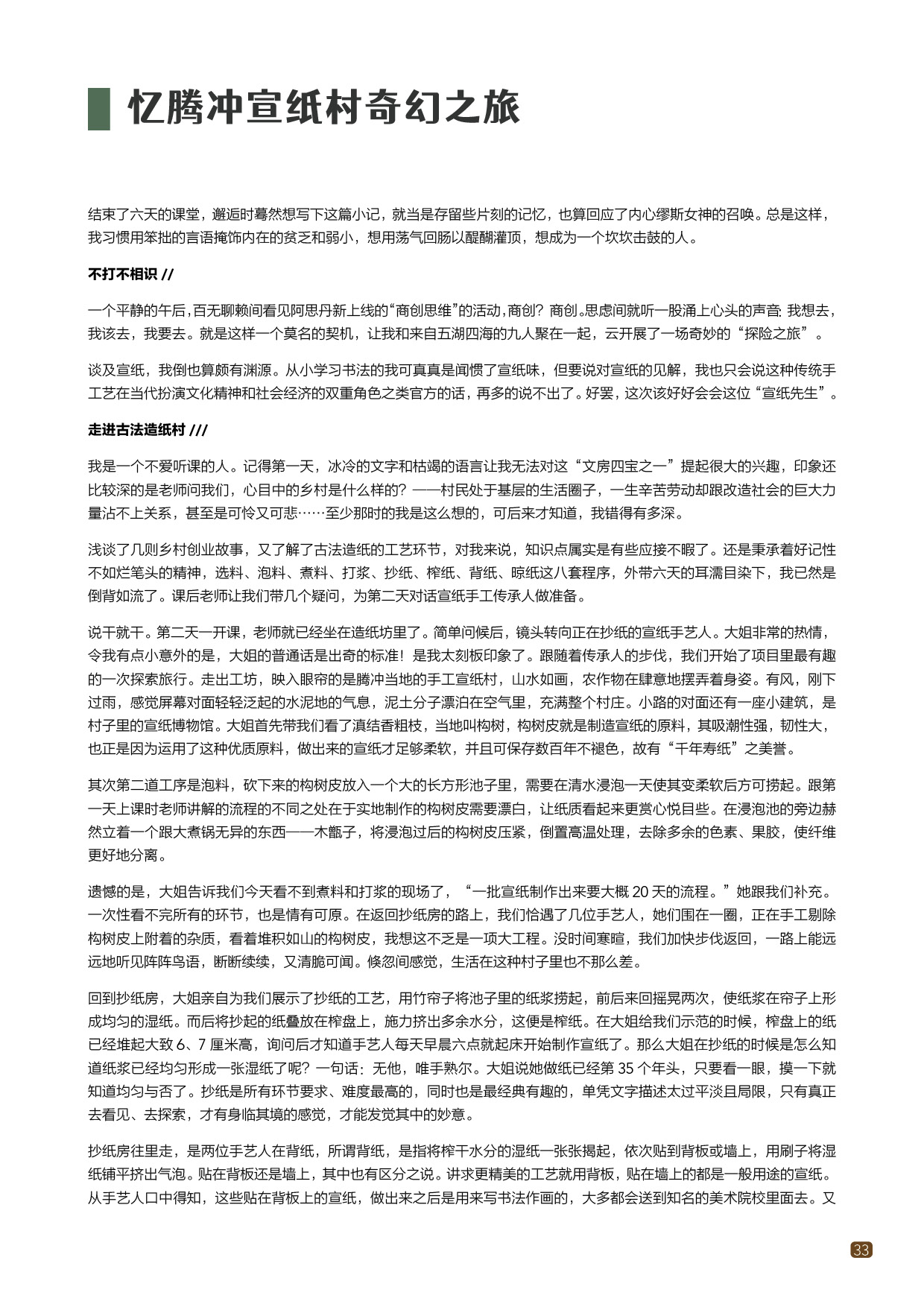我们的志愿者故事-乡村教育支持
让素质教育温暖触达乡村课堂
我们的志愿故事-动物与环境保护
是否珍稀,都应珍惜
是的,就是那束长春花。分别时,它还和来时一样,依在那个傣族阿姨的窗边。
我们的志愿故事-社区与特定人群关注
美好,从共益社区开始
An investigation into the connection between Alzheimer’s disease and gut microbes including prevention measures for Alzheimer’s disease
阿尔茨海默病与肠道微生物关系的研究,包括阿尔茨海默病的预防措施
研究概述:
本论文通过整合以往文献中的信息,研究肠道微生物如何通过神经系统影响阿尔茨海默症的发生。文中介绍了阿尔兹海默症的集中预防措施,包括饮食控制、益生菌治疗和环境卫生改变。通过文献综述,研究指出地中海饮食有助于维持肠道的稳态,益生菌能够改变阿尔茨海默症患者的肠道通透性。卫生学假说认为,充分接触微生物具有积极影响。尽管已经有许多实验支持了上述假设,但仍需要更多证据指导临床应用。
作者Author:沈珉熹 Minxi Shen
0Abstract
This dissertation mainly focuses on how gut microbes affect the occurrence of the Alzheimer’s disease through nervous systems by integrating the information from former literature. It also introduces several precautionary measures for Alzheimer’s disease, which include diet control, probiotics treatment, and sanitation change. At present, though many experiments have been conducted, showing support to this hypothesis, more theoretical evidence is still needed for confirmation of the hypothesis.
1Introduction
Alzheimer’s disease is one of the most common irreversible, progressive neurodegenerative disorder and the most common cause of dementia in the elderly, accounting for approximately 60%-80% of dementia cases [1]. While the pathological hallmarks of Alzheimer’s disease are well described, the underlying pathogenesis of the disease remains controversial [2]. The new hypothesis that gut microbes may be correlated to Alzheimer’s disease attracts me. I explored this topic mainly by doing secondary research including analyzing literature and studies. My objective was to integrate information to investigate the linkage between them.
2Gut microbes and Alzheimer’s disease
2.1Composition, metabolism, and functions of gut microbes
There are various species of gut bacteria in human body. Dysbiosis of the flora is associated with many metabolic diseases and ill-health state like diabetes, obesity, cardiovascular diseases, and inflammatory bowel diseases [3].
The function of gut microbiome is extensive. They produce neurotransmitters or neuromodulators (choline, tryptophan) and hormones in the gut [3]. Beyond metabolism, gut microbiome also plays a role in modulating immune system development by promoting formation of gut-associated lymphoid tissues, maintaining the intestinal epithelial barrier, and conditioning cells in the immune system [4]. While a healthy microbiome protects ourselves, microbial imbalance may predispose the organism to illness [4].
2.2Pathways for gut microbes to affect brain and Alzheimer’s disease
The central nervous system is a crucial ‘bridge’ for the mutual communications of gut microbes and the brain. The TLRs in host cells contribute to the production of cytokine which is key to their communications. And the dysfunction of gut microbiota may change the regulation of inflammatory response and cause extra effects on human’s brain and behaviors through central nervous system.
Another two ways are known as the autonomic nervous system and the enteric nervous system. They collaborate with central nervous system, promoting changes on brain and affecting the incidence of neurodegenerative diseases including Alzheimer’s disease by producing TLRs.
2.3Potential pathogenesis in Alzheimer’s disease
Lipopolysaccharides is the main components of the outer cell wall of gram-negative bacteria. Qiao et al. demonstrated that long-term administration of the bacterial endotoxin lipopolysaccharides markedly accelerated deposition of amyloid-β [5]. Their study well illustrates the correlation between lipopolysaccharides and amyloid-β, indicating that the excretion of gut microbes lipopolysaccharides is associated with Alzheimer’s disease as deposition of amyloid-β acts as an early stage and a main character of developing Alzheimer’s disease. Therefore, with the increasing permeability of the blood-brain barrier, it becomes easier for bacteria and their metabolites to penetrate the brain.
In addition to lipopolysaccharides, a significant quantity of functional amyloid can be generated by many bacterial strains, including Mycobacterium tuberculosis, and may contribute to the pathology of Alzheimer’s disease through the accumulation of proteinaceous misfolded amyloid-β oligomers and fibrils [6]. The precursor of amyloid gA, the main structural subunit of the bacterial amyloids, has a similar structure to Aβ42. The structure can be recognized by the TLR2 receptors in human body, triggering the production of pro-inflammatory cytokines. Consequently, neuroinflammation and neurodegeneration are triggered and contribute to the development of Alzheimer’s disease.
3Preventions
The Mediterranean diet features high consumption of olive oil, vegetables, legumes, grains, fruits and nuts, moderate consumption of fish and poultry, low consumption of full fat dairy products and red meat, and low-to-moderate consumption of wine [7]. Vegetables, fruits, and nuts are the most important sources of fiber and compounds against the oxidative process [8]. Olive oil, which acts as the major source of fat intake, offers high oleic acid content and polyphenols that have atherogenic antioxidant and anti-inflammatory effects [8].
Recent studies have shown that probiotics strains reduce oxidative stress and stimulate antioxidant enzymes in the brain [9]. After being provided with Lactobacilli and Bifidobacteria- based probiotics, the Mini-Mental State Examination scores of Alzheimer’s disease patients greatly improved [9]. Based on that and other similar experiments, probiotic intervention suggested a new therapeutic approach.
The hygiene hypothesis for Alzheimer’s disease suggests that the incidence of Alzheimer’s disease may be negatively associated with the abundance of microbes, which means that as the abundance decreases, the incidence of Alzheimer’s disease increases [10]. Dysfunction of the immune system caused by insufficient exposure to microorganisms through negative effects on T cells system may lead to the increase in the risk of Alzheimer’s disease [10].
4Discussion
To assess the correlation between the gut microbes and Alzheimer’s disease and prevention methods, I analyzed literature and the statistics in previous studies and did two interviews with experts to explore the mechanism and different hypotheses. However, the three precautionary methods are mostly based on experiments, so deeper research at more theoretical level is necessary to support its validity.
To defeat Alzheimer’s disease, several new drugs that can clear β-amyloid plaques or prevent tau phosphorylation were developed based on the amyloid cascade hypothesis, which centers on a cascade event of damages in neurons caused by the amyloid precursor protein [11]. However, these drugs have been proven to be almost completely invalid according to the results of clinical trials [12-15].
Therefore, due to the limited data regarding the variations in the microbial composition of those patients, future work must analyze the structural differences of the gut microbial content between Alzheimer’s disease patients and healthy individuals to provide insight into the mechanisms by which alteration influences Alzheimer’s disease and potential therapeutic targets. Large-scale analysis is warranted in the future to confirm the exact pathogenesis.
5Conclusion
This paper describes the functional characteristics of gut microbes associated with Alzheimer’s disease. Gut microbes, their metabolites, and other factors including aging, together contribute to the imbalance of gut microbes’ composition, leading to inflammatory responses that exacerbate Alzheimer’s disease pathology via different pathways. Mediterranean diet helps maintain the homeostasis in intestine. Probiotics are able to alter the intestinal permeability in patients with Alzheimer’s. Hygiene hypothesis suggests that adequate exposure to microorganisms has positive impacts. All the three methods are able to control the incidence of Alzheimer’s disease.
6Bibliography
2.Du, X., Wang, X., & Geng, M. (2018). Alzheimer's disease hypothesis and related therapies. Translational neurodegeneration, 7, p.2.
3.Kesika, P., Suganthy, N., Sivamaruthi, B.S. and Chaiyasut, C. (2020). Role of gut-brain axis, gut microbial composition, and probiotic intervention in Alzheimer’s disease. Life Sciences, p.118627.
4.Sun, M., Ma, K., Wen, J., Wang, G., Zhang, C., Li, Q., Bao, X. and Wang, H. (2020). A Review of the Brain-Gut-Microbiome Axis and the Potential Role of Microbiota in Alzheimer’s Disease. Journal of Alzheimer’s Disease, 73(3), pp.849–865.
5.Qiao, X., Cummins, D.J. and Paul, S.M. (2001). Neuroinflammation-induced acceleration of amyloid deposition in the APPV717Ftransgenic mouse. European Journal of Neuroscience, 14(3), pp.474–482.
6.Jiang, C., Li, G., Huang, P., Liu, Z., & Zhao, B. (2017). The Gut Microbiota and Alzheimer's Disease. Journal of Alzheimer's disease : JAD, 58(1), pp.1–15.
7.Georgoulis, M., Kontogianni, M. and Yiannakouris, N. (2014). Mediterranean Diet and Diabetes: Prevention and Treatment. Nutrients, 6(4), pp.1406–1423.
8.Del Chierico, F., Vernocchi, P., Dallapiccola, B. and Putignani, L. (2014). Mediterranean Diet and Health: Food Effects on Gut Microbiota and Disease Control. International Journal of Molecular Sciences, 15(7), pp.11678–11699.
9.Kowalski, K., & Mulak, A. (2019). Brain-Gut-Microbiota Axis in Alzheimer's Disease. Journal of neurogastroenterology and motility, 25(1), pp.48–60.
10.Hu, X., Wang, T., & Jin, F. (2016). Alzheimer's disease and gut microbiota. Science China. Life sciences, 59(10), pp.1006–1023.
11.Honig, L.S., Vellas, B., Woodward, M., Boada, M., Bullock, R., Borrie, M., Hager, K., Andreasen, N., Scarpini, E., Liu-Seifert, H., Case, M., Dean, R.A., Hake, A., Sundell, K., Poole Hoffmann, V., Carlson, C., Khanna, R., Mintun, M., DeMattos, R. and Selzler, K.J. (2018). Trial of Solanezumab for Mild Dementia Due to Alzheimer’s Disease. New England Journal of Medicine, [online] 378(4), pp.321–330. Available at: https://www.nejm.org/doi/10.1056/ NEJMoa1705971.
12.Egan, M. F., Kost, J., Tariot, P. N., Aisen, P. S., Cummings, J. L., Vellas, B., Sur, C., Mukai, Y., Voss, T., Furtek, C., Mahoney, E., Harper Mozley, L., Vandenberghe, R., Mo, Y., & Michelson,
D. (2018). Randomized Trial of Verubecestat for Mild-to-Moderate Alzheimer's Disease. The New England journal of medicine, 378(18), pp.1691–1703.
13.Egan, M. F., Kost, J., Tariot, P. N., Aisen, P. S., Cummings, J. L., Vellas, B., Sur, C., Mukai, Y., Voss, T., Furtek, C., Mahoney, E., Harper Mozley, L., Vandenberghe, R., Mo, Y., & Michelson,
D. (2018). Randomized Trial of Verubecestat for Mild-to-Moderate Alzheimer's Disease. The New England journal of medicine, 378(18), pp.1408-1420.
14.Gauthier, S., Feldman, H.H., Schneider, L.S., Wilcock, G.K., Frisoni, G.B., Hardlund, J.H., Moebius, H.J., Bentham, P., Kook, K.A., Wischik, D.J., Schelter, B.O., Davis, C.S., Staff, R.T., Bracoud, L., Shamsi, K., Storey, J.M.D., Harrington, C.R. and Wischik, C.M. (2016). Efficacy and safety of tau-aggregation inhibitor therapy in patients with mild or moderate Alzheimer’s disease: a randomised, controlled, double-blind, parallel-arm, phase 3 trial. The Lancet, 388(10062), pp.2873–2884.
15.Ricciarelli, R. and Fedele, E. (2017). The Amyloid Cascade Hypothesis in Alzheimer’s Disease: It’s Time to Change Our Mind. Current Neuropharmacology, 15(6).
我们的志愿故事-非遗文化传承
让文明跑赢时间
敦煌的荣光,前辈早已铸就。现在黄沙下的文明,需要我们这一代继续去坚守。文明的辉煌不在于时间的长短,是我们的文明给了时间的意义。敦煌能有今天的成就,前辈功不可没。













